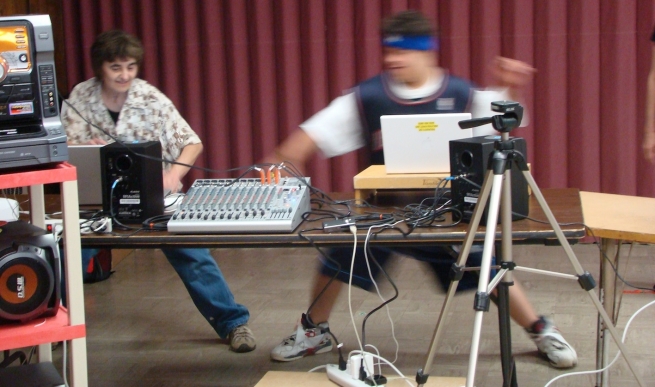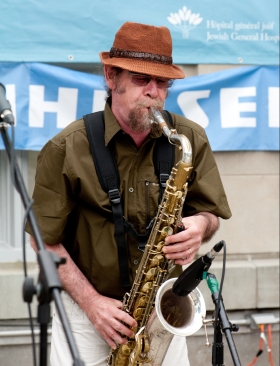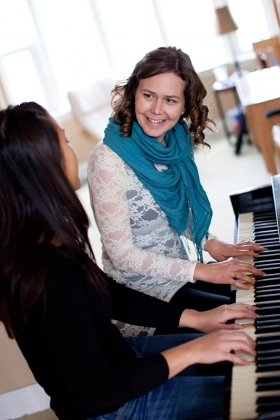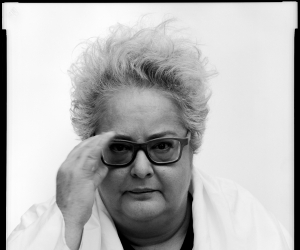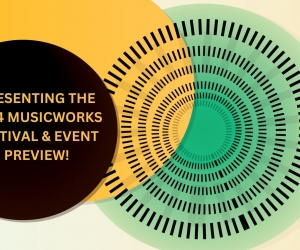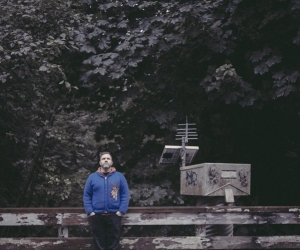One hundred and twenty kids, seated on benches and gym mats, are beaming as they beat out a pulsating rhythm on small percussion instruments. Their ecstatic expressions match that of drummer and occupational therapist Leaf Miller [ABOVE PHOTO, LEFT, working with student at Abilities First School, Poughkeepsie, NY] who is leading this massive jam session on an afternoon in early June at Montreal’s MAB-Mackay Rehabilitation Centre (known familiarly as the Mackay Centre), a school that for over 100 years has served children with motor, speech, or sensorial difficulties. Professional B-boy Luca “Lazylegz” Patuelli bursts out from the crowd with breakdancing moves that would be considered acrobatic even if he were not on crutches. B-boy-wannabes rush to the front to duo with him, and soon the floor is filled with movers and shakers. In the corner of the room, four computer stations are set up with the Adaptive Use Musical Instruments (AUMI) software interface, which enables children with limited mobility to engage in music-making. A lovely flute solo is created as the AUMI interface tracks one student’s head movements. The percussion fades, and the performance ends with improvised music from the quartet of AUMI players.
One week later in Montreal, the Jewish General Hospital’s fifteenth annual jazz festival is in full swing in its central lobby. Hospital hallways are not always associated with joy, but here smiles abound as the eight-piece Orkestar Kriminal pumps out Eastern European klezmer under a giant banner that declares: Music is Healing. The charismatic lead singer Giselle Webber urges all to interrupt their daily routines, and the space fills with patients holding IV poles and curious staff on their way to lunch.
Music has the capacity to change moods, form strong bonds between people, and prepare minds for thought. We become more mindful of others when improvising in a group, expand our consciousness and forget our pains with ritual music, and get riled up for activism with rebel music. So it is not surprising that music has been used as a form of therapy—acting both within and between individuals—for hundreds, if not thousands, of years. In the structured practice of trained professionals or, less formally, through self-discovery, music is used to heighten self-awareness, to spur cooperation in psychological counselling, and to improve social skills in people with autism, dementia, or schizophrenia. Musical rhythms have been proven to promote recovery of motor skills following a stroke. Music even plays a role in prenatal care, when a mother’s lullabies are heard in the womb, strengthening the mother–infant bond.
Music therapy would not exist in its current form were it not for avant-garde musical ideas. Modern composers give musical expression to modern experiences, opening up musical language in ways especially useful to music therapy. John Cage was particularly important in this regard, through his exploration of forbidden “nonmusical” sounds and his insistence that all sounds are valid. Similarly, free improvisation, as used in music therapy, is analogous to free association, the psychoanalytical technique developed by Freud in the late nineteenth century. Freely improvised music often mirrors the way verbal conversations progress: starting with small talk (small sounds) and proceeding to deeper meanings (denser sounds and interactions).
Few understand the connection between music and wellness more deeply than Bryan Highbloom [LEFT PHOTO], who has been the music therapist at Montreal’s Jewish General Hospital for the past thirty-five years and a master musician in the city’s free-improvisation scene since the 1960s. He plays saxophone in the Nouveau Jazz Libre du Québec, his duo with percussionist Guy Thouin, the only surviving member of Quatuor de Jazz Libre du Québec, the province’s first free-jazz group. Coincidentally, Quatuor’s original saxophonist Jean Préfontaine interned in psychology, with a stint as a music therapist at the Ste. Anne’s Veterans Hospital in Montreal’s West Island. In the 1970s, Highbloom was a member of the Atelier de musique expérimentale, representing the next generation of free improvisers, who were more influenced by European than American free jazz. Highbloom is founder and director of the JGH Jazz Festival, a two-week extravaganza that does not cling to the “safe” music one might expect in such an institution. In 2015, the wide-ranging lineup included the hard-hitting, avant-jazz sax-and-drums duo of Mette Rasmussen and Chris Corsano, contemporary classical sounds of Quatuor Bozzini, a solo set by Sam Shalabi on oud, and the aforementioned Orkestar Kriminal, among others.
Highbloom’s experiences in musical convalescence began during his university studies. “My academic work in Islamic studies led me to music therapy,” he explains. “I had a grant to study in Iran with Mehdi Haeri Yazdi, an ayatollah who chose me to be his student and, for five years, taught me the Eastern way of learning. All of the ayatollahs in Iran are trained Sufis as well, and I saw the ayatollahs heal with music. Sufis use a ritual trance called sama, [whose meaning is] close to what Pauline Oliveros would call deep listening. It is based on traditional Iranian music but varies depending on the Sufi. So, what I do comes in part from free jazz and what I did with the Atelier de musique expérimentale, and in part from my experiences in Iran.”
Following his studies in Iran, Highbloom got a job as an orderly at Montreal’s Royal Victoria Hospital. “I started to volunteer my services to play music for patients in the hospital. I applied all of the principles I learned in free music and all the principles I learned in sama to working with people, and right away it worked. It piqued my interest to use music for social action as opposed to entertainment.” The Royal Vic already had a music therapist working in palliative care, so Highbloom sought out other opportunities. “To use a hockey analogy, I looked for the open ice. There were doctors, there were therapists; so I went to the JGH and volunteered as musician-in-residence. The first group I saw there was all older ladies, slumped in their wheelchairs. I realized they were young in the 1920s, so I rocked them with tunes from the ’20s, and they all jumped out of their wheelchairs. I went two or three times a week and, at first, didn’t ask for money. But after a month I told them I needed to eat, and they gave me a job.”
Highbloom, who has no formal training in music therapy, takes an approach that is both similar to and different from more conventional methods. The music is often the end in itself, rather than a tool to open another door. “I talk to patients too, but there comes a time in any therapeutic discussion where you break down because there are too many words. I never write a treatment plan. If I am talking to someone and they are crying because their situation is so horrible, I acknowledge that and say that all I can offer at this point is a song that will say something or bring something out. The political, the mystical, and the musical all come in. By mysticism I mean something that is beyond what the mind can rationally work out.”
Because of the connection created through music, Highbloom is often the person to whom a patient will confide difficulties with hospital staff or procedures, and he will intervene on a patient’s behalf. In that sense, his work approaches classic music therapy, in that music creates a connection that often leads to solving a problem. “Most of the music therapists will work in one branch of medicine, whereas I work anywhere. I go from unit to unit; I play for the staff; I play for the patients; I play for the family members. I do not know of many other therapists who work in the intensive care unit. I go to the cardiac ICU and use the patients’ monitoring devices, heartbeats, and respirators as my score. A patient’s daughter came over to me one week while I was doing that and told me her mother loved music and asked if I would come over and play for her. She might not hear it because she is going to die within the next hour or two—at least that was what the doctors had told them. She liked a wild kind of Russian gypsy music, so I started to play, and the women jumped up and began to sing the song. The family started to cry. The next day the lady was still alive and conscious. I asked her what happened, and she said, ‘I was going down the tunnel and started to see the light, but then I heard your music, and I thought maybe I will just go back and party a bit more before I go to the light.’ Music is very powerful, and it does things that you cannot really understand.”
The music Highbloom plays outside of the hospital benefits from the broader range of music he plays inside. “To do this kind of work you need to give up your ego. At first I thought, How can I find something in ‘Tie a Yellow Ribbon Round the Ole Oak Tree’? But I forced myself to play it. Music therapy saved me from jazz-guy snobbery, and I learned it is all music. Whether I am playing with the NJLQ or whether I am playing for the nurses when they are writing their charts, I am doing sama, deep listening, all the time.”
Renowned for her association with deep listening, Pauline Oliveros has equally deep connections to music therapy. In 2007, she was approached by therapist Leaf Miller, who wanted to find a way to include in her drum circles children who were unable to hold a drum. This encounter led to Zane Van Dusen, a student of Oliveros at the time, developing the original prototype for Adaptive Use Musical Instruments (AUMI), working on a team with Oliveros and others. The system has seen rapid development since then, with free versions for Mac, PC, and iPad now available. An AUMI consortium—including groups at Rensselaer Polytechnic Institute and Kansas University in the U.S., and at Carleton, Lakehead, McGill, and Memorial universities in Canada—ensures the continued research and development of the software.
AUMI combines motion tracking, using a standard Web camera, with sound synthesis. The software continually tracks the X and Y coordinates of a point on the user’s body and uses the information to trigger musical events. Any part of the body can be used, such as the tip of a nose or even the eye, for those with very limited movement. There are several modes of operation, including a screen split into two or more sections, and a percussion mode. Any sound can be stored for later recall and manipulation, creating a versatile tool that can be played by virtually anyone. “Traditional instruments have been designed with normalized notions of the body. But there is no such thing as a normalized body, in terms of dimensions or range of motions or capabilities,” says Eric Lewis, a professor of philosophy at McGill University and leader of the AUMI project at the Mackay Centre. “Digital technologies like AUMI allow people to easily play a musical instrument outside normalized notions of the body.”
Lewis also directs McGill’s Institute for the Public Life of Arts and Ideas, and is the McGill site coordinator for Improvisation, Community and Social Practice (ICASP), a pan-Canadian project that studies improvisation as a model for political, cultural, and ethical dialogue and action. “Aristotle thought that music sounds the way emotions feel,” Lewis says. “Music is about expression. How do we tell people how we are feeling? The easiest way is to tell them. Kids who cannot talk cannot do that. Or you can read facial expressions. But kids with autism or who are blind cannot pick up these visual cues. Maybe music is a form of expressiveness they do understand. If you lack the standard ways of communicating your feelings, music can be a powerful alternative.”
At the Mackay Centre, music has been used to help children attain specific goals, which are established for each individual at the beginning of the program. “Getting kids to say please and to share is one goal,” Lewis says. “In order to use AUMI in a group setting, they have to cooperate with other children. Another goal is cause and effect. If you do not interact with the world much, it is difficult to understand cause and effect. AUMI makes the children realize they made that sound. Even just having fun together is important. Children in wheelchairs who have limited motor control and limited command of language have very few opportunities for collective creative play. It is therapeutic because you are no longer an isolated being navigating the world: you are doing something with other people who know how to read your expressive codes. How can that not be healing?”
Software like AUMI breaks down barriers in performance, allowing mixed orchestras of people with different abilities, and percussion instruments are particularly useful in music therapy, allowing unskilled musicians to easily participate. Composer, percussionist, and visual artist Jesse Stewart, a member of the Carleton University AUMI group, has produced aesthetically high-standard works with people using AUMI. He is the founder of We Are All Musicians (WAAM), an organization dedicated to the idea that everyone deserves an opportunity to play music, regardless of their level of musical training, physical or cognitive ability, etc. WAAM has performed at the National Arts Centre in Ottawa, in addition to running regular workshops.
Like Highbloom and Stewart, Lewis’ experiences in music therapy have informed his own music. He plays trumpet in groups such as Montreal’s Murray Street Band, and electronics in the Instant Synthesis Ensemble, which is based in Athens, Greece. Lewis explains how he has experimented with AUMI in performance. “You can load whole songs and manipulate their speed and acceleration using relative motion while you are playing another instrument. In one concert, I was playing trumpet and processing my trumpet sounds, but my movements were also manipulating sounds through AUMI.”
Music therapy can also support practising musicians
in other ways. Deborah Seabrook [RIGHT PHOTO, seated right], an accredited music therapist with a Master of Music Therapy degree, has worked with patients in palliative care, and with people who have experienced trauma or abuse. She sings as an alto in Ottawa’s Capital Chamber Choir, and improvises on piano in various group settings. Her current music therapy practice in Ottawa explores the use of what she calls clinical improvisation, which is rooted in the person-centred psychotherapy technique developed by American psychologist Carl Rogers in the 1940s and ’50s. In her sessions, Seabrook tries to create music which honours and empathizes with the other musicians. Clients are invited to improvise in the moment, experiencing a safe space to express themselves creatively. Seabrook accompanies, attempting to reflect, affirm, and challenge the client’s musical offerings. After the session, participants may choose to verbally discuss the experience.
“Clinical improvisation is different from other forms of musical improvisation because it is focused on the client,” she explains. “This can result in enhanced competency and confidence in their own musicianship, with more freedom, spontaneity, and a higher level of creativity, even when playing composed works.” At a workshop held in 2015 at The Banff Centre, Seabrook worked in private duo sessions with musicians, who later gathered for a public group performance. “There was extraordinary in-the-moment immediacy creating a very powerful experience. The audience equally saw that the music was genuine.”
Donning his academic hat, Lewis muses on the connections between philosophy, music, and health. “Plato said the philosopher is someone who has the motions of the parts of their soul in proper harmony with each other. The music is built in. It is thus not surprising for a philosopher to be concerned with the healing arts, and in that sense, Albert Ayler was a great philosopher when he wrote ‘Music Is The Healing Force Of The Universe.’ A lot of improvisers today see their work as a form of therapeutic practice. As researchers, we take these observations by pioneering musicians and philosophers, which we know are right, and try to lift up the hood to see what is going on.”
Music therapy is a burgeoning field. Technology has expanded the reach of music therapy to new populations, and research continues to refine the methodology and roles it can play in healing minds, bodies, and spirits. Children may not realize that their fun is, in fact, part of a premeditated therapeutic intervention, but they will benefit from these advances as much as adults who deliberately seek out the aid of a music therapist. Music continues to work in mysterious ways. “People are bored to death in hospitals, and their lives are hanging in the balance,” says Highbloom. “Then someone comes in and plays the music they love.”
